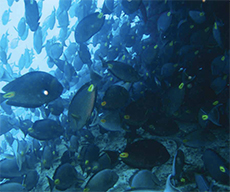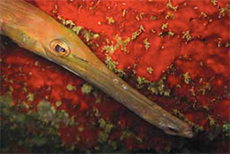




| Home | Features | Club Nights | Underwater Pics | Feedback | Non-Celebrity Diver | Events | 23 April 2024 |
| Blog | Archive | Medical FAQs | Competitions | Travel Offers | The Crew | Contact Us | MDC | LDC |

|

|
 
 |
 |
ISSUE 13 ARCHIVE - REBUILDING NATURE IN CAPE VERDEJuliette ClaroThere is something quite paradoxical about Cape Verde as the name does not reflect the land at all. Instead of green foliage and rainforest which you may be dreaming of whilst booking your trip, you land on a very hot, brown, rocky and windy archipelago. The islands hold their name after the place in mainland Africa, called Cabo Verde, where the slave trade left from during the times where the Cape Verde Islands served the purpose of an exchange platform during the colonial times. |
 |
 |
So, no green land, no jungle, no mountains (or just little brown rocky hills), and one huge building site that is the island of Sal. Sal is the main island of the archipelago where you are likely to land, especially for those who go on all inclusive package holidays. All inclusive? You mean Butlins and Thomson? Well... after the disruptions in Egypt, Tunisia and the rest of North Africa, the tourism industry is now playing the Cape Verdean 'No stress' card.
Buses and charters of holiday goers desperate for the beer in the sun they feel they deserve in those difficult economic times... Sal is developing massively in many aspects and at many costs. Despite the fact that the islands have a huge shortage of water, the main attraction in Cape Verde is... water. |
|
 |
Being in the middle of the Atlantic, Cape Verde has warm currents and winds which make the islands paradisiac for water sports enthusiasts. Ponta Preta hosts the wind surfing world championship every year in the South of Sal.
The sea in Cape Verde is full of life and species which you will struggle to find anywhere else in the world. I mean so many fish around you that it gives you vertigo. So many that even your bubbles don't push the fish away! It is quite amazing. I admit I was stunned. I was even more stunned when Nounou, at Manta Diving Center, told me that the sea life is regressing and is at it's all time low of the last two decades. Cape verde has lost over sixty percent of the biomass of the islands in the last twenty years. The reasons for this are various, from pollution to over fishing and bad government regulations. The result is scary: Cape Verde is now only visited by turtles from June to September when they used to see them everywhere all year round. Barracudas that were prolific around the islands just fifteen years ago, have disappeared. Being at the top of the food chain is not so cool there anymore as they have nothing left to munch on, so they go away. |
 |
 |
Nounou has been in Cape Verde for over twenty years. He is the father to the project 'Rebuilding Nature' and the man behind all operations at Manta diving Center in Santa Maria – Sal. His task is difficult: to make the Cape Verdean Government aware of the problems in order to bring about a difference in a small country often full of obstacles and frustrating laid back customs.
The idea is not new, but Manta Diving Center has managed to 'recycle' two old ships and sink them to create artificial reefs. A team of scientists from all around the world have volunteered to get involved in measuring the impact of the new reefs on the biomass in the sea of Cape Verde. The results are unprecedented: in nineteen days the wrecks were covered in plankton and algae. In less than one month, Shoals of fish were back in the waters of Sal. Scientists have studied the phenomenon and are still commenting on the rich biodiversity in the sea of Cape Verde. |
|
 |
The two ships were sunk at depths of 28 and 30 metres, one mile off the coast of Santa Maria and they are now major artificial reefs which attract not only fish but also many divers. Barracudas are slowly returning and the life under the sea is rebuilding incredibly well, but it is still very fragile.
Manta Diving Center is planning on sinking another ship next year which will also be studied by scientists and by the Cape Verdean government which is slowly realising the economic potential of the sea that surrounds the archipelago. |
 |
 |
Cape Verde is an amazing place where even the fish appear laid back. It has the most diverse sea life you could dream of in the Atlantic Ocean; and all of it without the need of a dry suit! It has the most stunning caves full of beautiful yellow flower corals, lobsters, and hugely dense schools of fish. Wrecks are accessible for inexperienced divers at 11 metres or at depths up to 40 metres. Wrecks are all massive artificial reefs with abundant life from white spotted moray eels to turtles who come by any time.
|
|
|
Rebuilding Nature and Manta Diving Center have a huge impact on the diving in Santa Maria. Nounou and his committed staff will guide you to the best dive sites around the islands from wrecks and caves to drift dives at mach 12 (remember you are in the Atlantic Ocean and currents are strong and often unpredictable).
As the Cape Verdeans say, "No stress Man, enjoy the dives and... relax." Best dive sites on Sal:
|
 | |
Previous article « Editorial Next article » Sardine Run Back to Issue 13 Index | ||